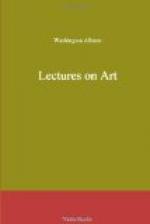This is Invention; we have not moved a step through the picture but at the will of the Artist. He invented the chain which we have followed, link by link, through every emotion, assimilating many into one; and this is the secret by which he prepared us, without exciting horror, to contemplate the struggle of mortal agony.
This too is Art; and the highest art, when thus the awful power, without losing its character, is tempered, as it were, to our mysterious desires. In the work of Ostade, we see the same inventive power, no less effective, though acting through the medium of the humblest materials.
We have now exhibited two pictures, and by two painters who may be said to stand at opposite poles. And yet, widely apart as are their apparent stations, they are nevertheless tenants of the same ground, namely, actual nature; the only difference being, that one is the sovereign of the purely physical, the other of the moral and intellectual, while their common medium is the catholic ground of the imagination.
We do not fear either skeptical demur or direct contradiction, when we assert that the imagination is as much the medium of the homely Ostade, as of the refined Raffaelle. For what is that, which has just wrapped us as in a spell when we entered his humble cottage,—which, as we wandered through it, invested the coarsest object with a strange charm? Was it the truth of these objects that we there acknowledged? In part, certainly, but not simply the truth that belongs to their originals; it was the truth of his own individual mind superadded to that of nature, nay, clothed upon besides by his imagination, imbuing it with all the poetic hues which float in the opposite regions of night and day, and which only a poet can mingle and make visible in one pervading atmosphere. To all this our own minds, our own imaginations, respond, and we pronounce it true to both. We have no other rule, and well may the artists of every age and country thank the great Lawgiver that there is no other. The despised feeling which the schools have scouted is yet the mother of that science of which they vainly boast. But of this we may have more to say in another place.




